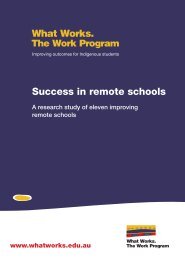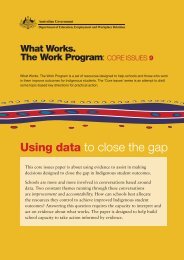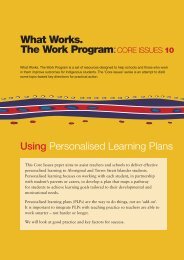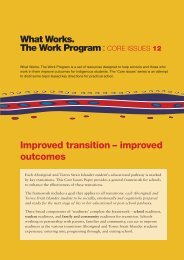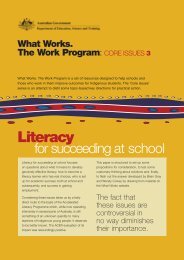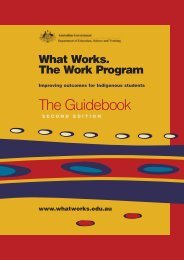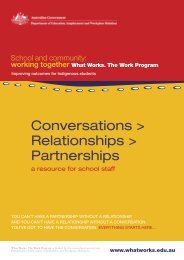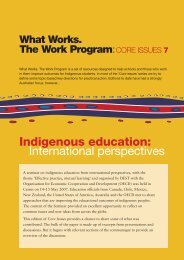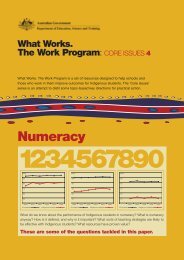Bound for Success Scope and Sequence Statements
Bound for Success Scope and Sequence Statements
Bound for Success Scope and Sequence Statements
- No tags were found...
Create successful ePaper yourself
Turn your PDF publications into a flip-book with our unique Google optimized e-Paper software.
STUDIES OF SOCIETY AND ENVIRONMENTInquiryNote that this str<strong>and</strong> be addressed simultaneously with all SOSE content str<strong>and</strong>sConcept In Year 1the student:In Year 2the student:In Year 3the student:In Year 4the student:In Year 5the student:In Year 6the student:In Year 7the student:In Year 8the student:In Year 9the student:Plans investigations• Identifies an area <strong>for</strong>investigation (somethingthey want to find outabout).• Talks about a topic usingtheir own experience orstimulus such as a picture,film or story (e.g. talksabout how people used toget from one place toanother be<strong>for</strong>e cars wereinvented, having seen thefilm…….).• Identifies an area <strong>for</strong>investigation <strong>and</strong>brainstorms somequestions they want theinvestigations to answer.• Describes what is going tobe investigated <strong>and</strong> howthey will collectin<strong>for</strong>mation. N• Plans an investigation <strong>for</strong>a topic by collaborativelypreparing a step-by-stepplan.• Identifies possible sourcesof in<strong>for</strong>mation appropriateto a topic <strong>and</strong> decides howthey will be used to gainin<strong>for</strong>mation.• Independently identifiesthe requirements of aninvestigation (e.g.explains, describes, usesstatistical evidence).• Applies the requirementsof an investigation to arelevant, social issue intheir local communitysuch as graffiti orviolence.• Analyses asocial/environmentalissue, <strong>for</strong>mulatesquestions <strong>and</strong> plans waysof investigating them (e.g.plans to investigatemulticulturalism byexplaining it, describing it,<strong>and</strong> gathering statisticaldata about it). NDesigns questions • Poses simple questions togather in<strong>for</strong>mation or seekclarification (e.g. says“Who are those people?”).• Designs questions <strong>for</strong>investigation (e.g. writes“how did Aboriginal <strong>and</strong>Torres Strait Isl<strong>and</strong>erpeople live?”).• Designs questions to askgroups or individuals (e.g.decides to ask the Chinesepeople in the community:“did you come here fromChina or was it yourparents orgr<strong>and</strong>parents?”).• Designs inquiry questionslinked to the purpose ofthe investigation ( e.g. ininvestigating BritishColonisation writes “Howdid British Colonisationaffect the lives ofAboriginal <strong>and</strong> TorresStrait Isl<strong>and</strong>er peoples?”).• Designs focus questions(in groups) to investigate atopic (e.g. in investigatingBritish Colonisation <strong>and</strong>how it impacted on thelives of Aboriginal <strong>and</strong>Torres Strai t Isl<strong>and</strong>erswrites the question “Howdid your ancestors findfood?”).• Designs focus questions<strong>and</strong> sub-questions frombroad inquiry topics (e.g.in investigating a worldevent that brought aboutsignificant change; such asAustralian Federation;writes questions such as:“did Queensl<strong>and</strong> want tobe part of theFederation?”• Designs focus questions togather inferential <strong>and</strong>interpretive in<strong>for</strong>mation toelicit a person’s viewpoint(e.g. “what do you thinkabout reconciliation?).• Recognises bias indesigned focus questions.Collects/Gatherssorts <strong>and</strong> organisesin<strong>for</strong>mation <strong>and</strong>evidence(independently <strong>and</strong>collaboratively.)• Gathers materials <strong>and</strong>answers from familiarplaces <strong>and</strong> people by firstlocating them in the schoolcommunity (e.g. goes tothe school library <strong>and</strong> askthe librarian where thebooks about Australia are).• Gathers in<strong>for</strong>mation fromsources, includingnarratives on individuals<strong>and</strong> groups who contributeto the local community(e.g. asks Mr Smith at thePost Office how long thePost Office has been there,or their gr<strong>and</strong>father aboutwhat school was like whenhe went).• Selects useful in<strong>for</strong>mationby using simple scanningtechniques (e.g. looks atbooks covers, pictures <strong>and</strong>titles).• Gathers evidence <strong>and</strong>in<strong>for</strong>mation from a rangeof sources (including theinternet, interviews,photos, stories).• Uses indexes <strong>and</strong> headingsto select relevantin<strong>for</strong>mation in resources.• Gathers evidence <strong>and</strong>in<strong>for</strong>mation from a rangeof sources <strong>and</strong> recordsin<strong>for</strong>mation gathered (e.g.uses an audio recorder torecord the narrative of anelderly man in thecommunity describing anevent in the past).• Gathers a range ofevidence (includingnarrative <strong>and</strong> nonnarrativeaccounts)showing differentperspectives <strong>and</strong> recordsuseful in<strong>for</strong>mation using avariety of techniques.• Knows the differencebetween primary <strong>and</strong>secondary sources.• Gathers in<strong>for</strong>mation frommore than one secondarysource (e.g. reads severalaccounts or narrative <strong>and</strong>gathers two or moredifferent interpretations ofthe same event).• Gathers in<strong>for</strong>mation fromprimary <strong>and</strong> secondarysources showing differentperspectives (e.g. gathersartefacts, photographs,books, newspaper articlesor films) <strong>and</strong> determineswhether they are useful ornot useful <strong>for</strong> theirpurpose, describing whyor why not.• Gathers in<strong>for</strong>mation fromprimary <strong>and</strong> secondarysources that revealdifferent values <strong>and</strong>beliefs.• Gathers in<strong>for</strong>mation fromprimary <strong>and</strong> secondarysources choosing thosethat are appropriate, <strong>and</strong>uses different methods torecord the in<strong>for</strong>mationgathered that is useful(e.g. mobile phone, digitalcamera, tape- or videorecorder, scans,photocopies).• Sorts objects <strong>and</strong> artefactssuch as photos, books <strong>and</strong>pictures. N• Sorts photos related to atopic (e.g. says “these areold photos of the town <strong>and</strong>these aren’t as old”). N• Arranges personalexperiences in order.• Organises one type ofin<strong>for</strong>mation (e.g. put datescorrectly in order on atimeline, <strong>and</strong> arranges aseries of photographs torepresent the past <strong>and</strong> thepresent.• Groups or labels objects ina display.• Organises in<strong>for</strong>mationthey have gathered fromtalks, interviews, simplesurveys, books <strong>and</strong> theinternet.• Organises in<strong>for</strong>mationthey have gathered bynote-taking, sketching,audio-taping, video-taping<strong>and</strong> photographing.• Organises <strong>and</strong> categoriesin<strong>for</strong>mation using digitalfiling methods ICT• Organises ideas <strong>and</strong>in<strong>for</strong>mation logically.• Chooses between two<strong>for</strong>mats to organisecollected in<strong>for</strong>mation <strong>and</strong>evidence <strong>and</strong> justifies theirchoice in the context (e.g.chooses to record theinterview using anaudiotape rather thantaking notes so that theycan listen to it again later).ICT• Chooses between a rangeof <strong>for</strong>mats to organisecollected in<strong>for</strong>mation <strong>and</strong>evidence <strong>and</strong> justifies theirchoice in the context (e.g.says “we decided to scanall the old photos becausewe didn’t want to damagethem by h<strong>and</strong>ling <strong>and</strong> sothat we could easily printout copies when weneeded them”). ICT• Organises data so thatconclusions related to theoriginal aims of theinvestigation can bedrawn.• Decides how thein<strong>for</strong>mation will beorganised be<strong>for</strong>eattempting to collect <strong>and</strong>gather it in order tominimise problems withretrieval (e.g. decides toscan all newspaperclippings <strong>and</strong> store inelectronic files, decides tostore learning objectURLs in their favouriteslist). ICTEvaluates gatheredin<strong>for</strong>mation <strong>and</strong>evidence(independently <strong>and</strong>collaboratively).• Knows that theirviewpoint can be differentfrom someone else’s (e.g.says “he thinks the dog isnice but I think it isawful”).Recognises differentviewpoints in narratives (e.g.says “in the story Mario saidthat his friend didn’t tell thetruth but Mario’s brothersaid that he did”).• Recognises differentviewpoints or values innarratives or evidencerelating to familiar orcommunity events.• Decides whether evidence<strong>and</strong> in<strong>for</strong>mation is relevantor not relevant.• Assesses primaryevidence to identify facts<strong>and</strong> opinions.• Gives reasons <strong>for</strong>accepting or rejectingin<strong>for</strong>mation.• Assesses evidence fromsecondary sources toidentify facts <strong>and</strong> opinions(e.g. reads narratives thatpresent a view onAustralia be<strong>for</strong>e <strong>and</strong> afterBritish colonization <strong>and</strong>determine those which• Analyses secondarysources presented indifferent <strong>for</strong>mats to detectpoints of view (e.g.identifies differing pointsof view or perspective bycomparing a segment of afilm to a written textdescribing/depicting the• Analyses <strong>and</strong> comparessources of evidence <strong>and</strong>suggests possible reasons<strong>for</strong> different points ofview (e.g. suggests that adescription of Australia asan awful place waswritten by a Britishpatriotic officer missing• Assesses evidence <strong>for</strong>relevance, authenticity,reliability <strong>and</strong> purposewhen comparinginterpretations derivedfrom primary <strong>and</strong>secondary sources of thesame event.• Assesses evidence <strong>for</strong>relevance, authenticity,reliability <strong>and</strong> purposewhen comparing their owninterpretation of pictures<strong>and</strong> narrative with theinterpretation of anotherauthor.<strong>Bound</strong> <strong>for</strong> <strong>Success</strong> <strong>Scope</strong> <strong>and</strong> <strong>Sequence</strong> <strong>Statements</strong> V2 Page 65 Working Document Semester One 2007



